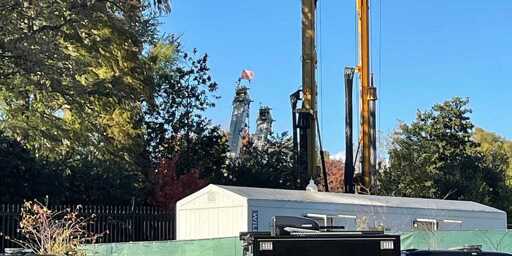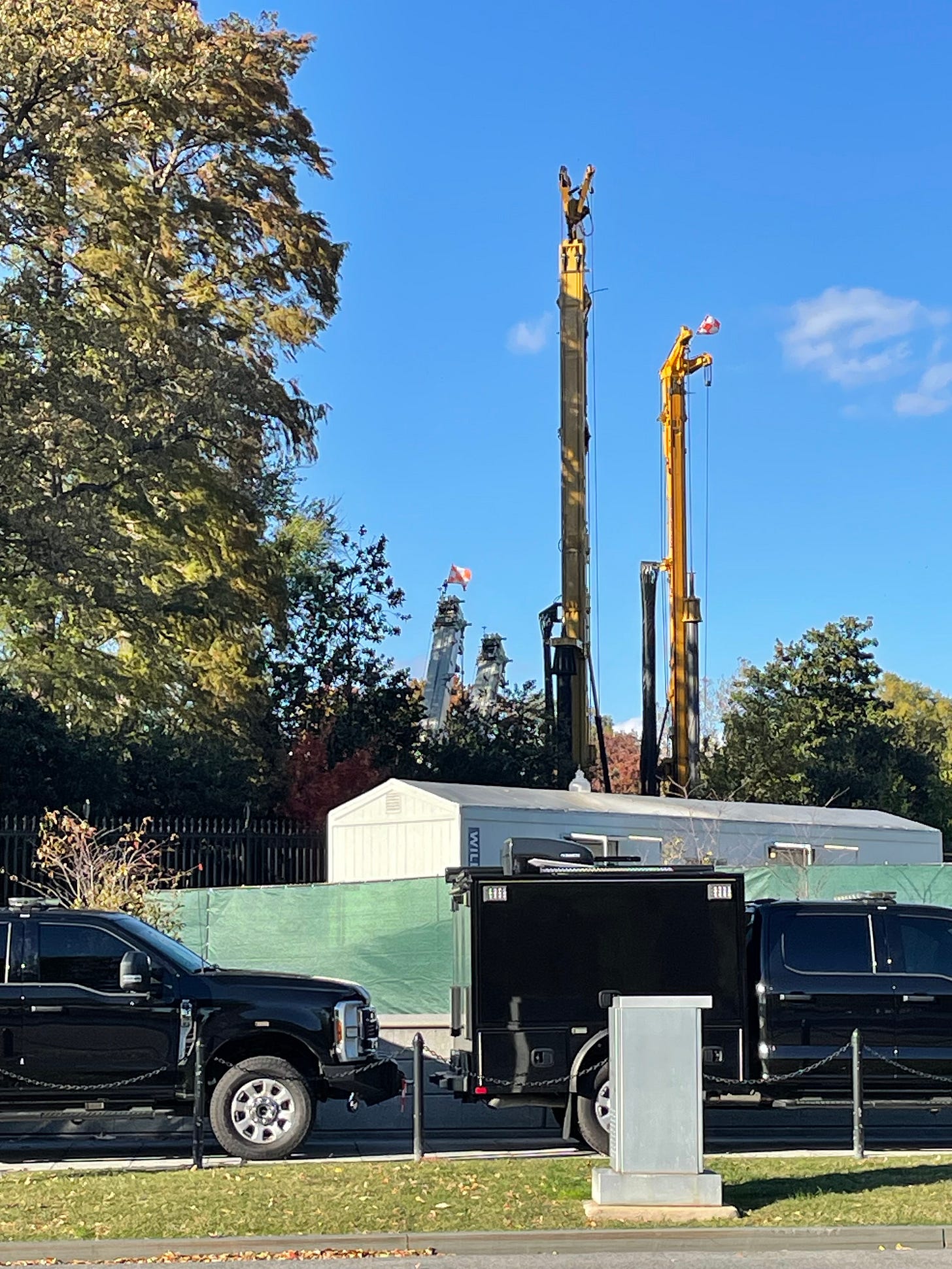The policewoman jumped out, whistled, and told us to stop.
It was the afternoon of Hallowe’en in Washington DC, and I was walking with a friend from Adams Morgan down to the Mall. It’s a city where I feel at home. I visited in 1987, as part of National High School Mock Trial Championship, and lived in DC for summers before, during, and after college. The afternoon of October’s last day was beautiful, and my mind was dwelling in other sunny days, other strolls down the same path – 17th St, alongside the White House compound, approaching State Place.
And then she appeared from nowhere, our energetic policewoman, officiously stopping the foot traffic; we had to wait and watch. A skilled semi driver had appeared, incongruously, at the tight intersection; he had to back his load through a narrow entry into the White House which had been designed for no such thing. It was not just that the passage was too small; no one on the other side of the checkpoint, on the White House grounds, had made any preparations, and cars beyond the gate were parked needlessly close. It took the driver several minutes to find his way in, which gave me time to think about what was so troubling in all this.
By the time of my visit to the nation’s capital, our president had already leveled the East Wing of the White House, the side where the public entrance used to be, where guests were once welcomed. We were standing on the west side of the complex, watching a movement of heavy machinery that seemed arbitrary, unplanned, and chaotic. Since the semi driver had to make a whole series of turns before backing in, it was not hard to see his load: a CZM utility drilling rig. It would join the collection of other heavy equipment at the edge of a pit.
Why was this troubling? The destruction of the East Wing is the vanity project of someone who regards the White House as a permanent private residence. I presume that the expansion of the bunker is more important than whatever might be built on the surface. Given that the parts of the White House that are still standing are being redecorated with fake-gilded Home-Depot gewgaws, any ballroom would likely be hideous. The impression given in every Trump endeavor is that he takes everything for himself, and yet somehow never has the money to hand to do anything right. He has endless donations, but no one seems to know where it is.
At the end of my walk, about an hour later, I met a second friend who, as it happened, was on that mock trial team back in 1987, and also visited Washington with me and a larger group from my high school. Seeing him, I think, helped me understand just why I was troubled.
During our week in the capital, back then, we were hosted and guided around by a group called Close-Up. They were (are) non-partisan, and our stops and lectures were all designed around a simple theme: all of this, the Mall, the monuments, the city, belongs to us, as Americans. It is not just that the East Wing existed back then, and that no policewomen were jumping out to block our tours: the whole complex was much more open, as was the whole city. Now you cannot get close-up to anything. The White House, we were told, was also called the People’s House.
The non-view of what used to be the East Wing, and is now an oligarchical pit.
I know that this sense of belonging had something to do with where I was coming from, a white kid from a good school being celebrated for some achievement, with a week in the capital and a hotel room and all the bills paid. And I know my perspective then was limited, and no doubt still is. The policewoman jumping into view was a spur to thought, but not a threat. The history of Washington DC is full of the race and class injustices that haunt our other cities.
So I was young and I was naive the first time, around forty years ago, that I walked around the White House. And yet that idea, that these spaces should belong to us, the people, is essential for any possible American democracy. It has of course never been fulfilled, but there is a difference between the partial realization of an ideal and its contemptuous rejection. The heavy equipment halting the natural flow of people in order to wreak oligarchical havoc behind walls of mendacity obfuscation and graft – that felt like rejection, dismissal, scorn.
For someone like the president, or the vice-president, or for that matter for the surrounding clutch of oligarchs, none of what I write here has any meaning. For them, it is unthinkable that something – a space, a monument, a White House, a city, a country – could belong to the people and not to a private individual. And it is within that vacuum of values, that they live and they act. And so they dig a pit for themselves where once we had a meeting place which, with time and work, might have been for everyone.
This Trump thing will not work. It cannot work. But the destruction has gone far enough, the nihilism has dug deep enough, that we cannot think about going back. Even the idea of rebuilding is not enough.
If there is an America on the other side of this, it will have to be a different country, a better one, based not on the restoration of hopes that people my age once had, but on a broader sense of the future, a better American dream. I think that this America is in there, beneath the pain and the indignation; I believe that it is out there, among the voters and the protests. It will take work, work not of pits and barriers, but of organization and courage.
Thinking about… is a reader-supported publication. To receive new posts and support my work, consider becoming a free or paid subscriber.
For positive solutions see On Freedom
From Thinking about… via this RSS feed



